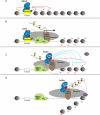Multiple faces of the SAGA complex
- PMID: 20363118
- PMCID: PMC2900470
- DOI: 10.1016/j.ceb.2010.03.005
Multiple faces of the SAGA complex
Abstract
The SAGA complex provides a paradigm for multisubunit histone modifying complexes. Although first characterized as a histone acetyltransferase, because of the Gcn5 subunit, SAGA is now known to contain a second activity, a histone deubiquitinase, as well as subunits important for interactions with transcriptional activators and the general transcription machinery. The functions of SAGA in transcriptional activation are well-established in Saccharomyces cerevisiae. Recent studies in S. pombe, Drosophila, and mammalian systems reveal that SAGA also has important roles in transcript elongation, the regulation of protein stability, and telomere maintenance. These functions are essential for normal embryo development in flies and mice, and mutations or altered expression of SAGA subunits correlate with neurological disease and aggressive cancers in humans.
Copyright 2010 Elsevier Ltd. All rights reserved.
Figures

References
-
- Brownell JE, Zhou J, Ranalli T, Kobayashi R, Edmondson DG, Roth SY, Allis CD. Tetrahymena histone acetyltransferase A: a homolog to yeast Gcn5p linking histone acetylation to gene activation. Cell. 1996;84:843–851. - PubMed
-
- Weake VM, Workman JL. Histone ubiquitination: triggering gene activity. Molecular cell. 2008;29:653–663. - PubMed
-
- Nagy Z, Tora L. Distinct GCN5/PCAF-containing complexes function as co-activators and are involved in transcription factor and global histone acetylation. Oncogene. 2007;26:5341–5357. - PubMed
Publication types
MeSH terms
Substances
Grants and funding
LinkOut - more resources
Full Text Sources
Molecular Biology Databases

